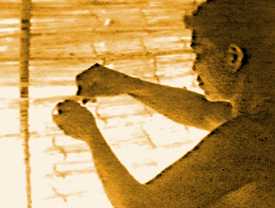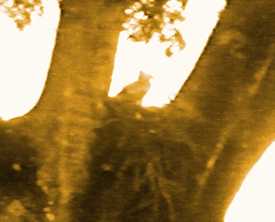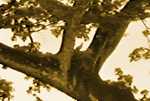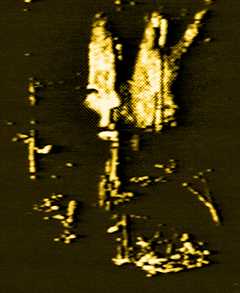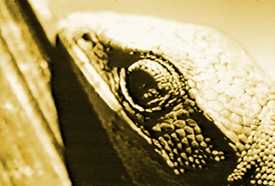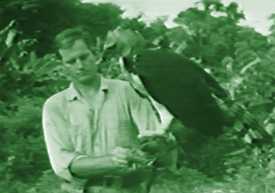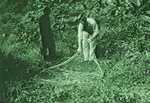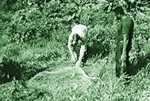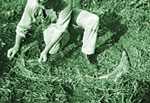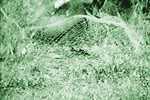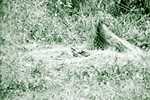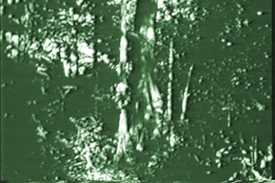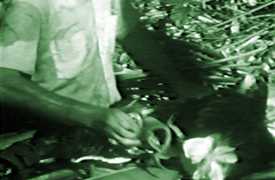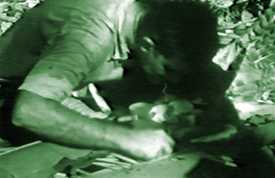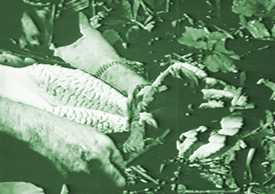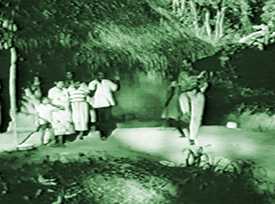Trapping the Eagle
by Jim Fowler
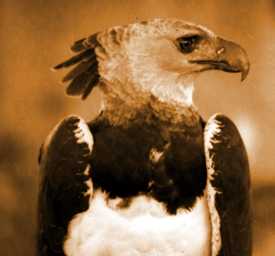 |
I decided to try my backup idea. To set a trap on the limb I was on. After all, the harpy was used to finding food there. Food that a parent had supplied for it. I used my flashlight to signal that "Plan Two" was in effect. That my cohorts should send up some materials that I had in my blind. Materials I needed to construct a noose trapping system. A system that I'd used to catch birds of prey in other places in the world (never in a rainforest, however). It was certainly worth a try. I was dead tired but I was "pumped" at the same time. Yes, this limb was going to be the trapping place for sure. And I was determined to give it a go that very evening!
Here's what the noose system is all about
You take 40-pound nylon filament and develop a whole pattern of nooses that end up resting atop your trapping site. (In my case, the limb.) Then you place your bait in the middle of the noose arrangement. You're hoping, of course, that the eagle lands near the bait and gets its feet caught in some of the large nylon nooses. You know when it's caught when you see its wings extending and it's trying to fly away. When that happens, you start pulling in on a quarter-inch line that tightens the nooses. You then slowly ease out another line so the bird makes a soft landing on the ground.
After the team sent up my materials, I spent about an hour rigging the trap. The nooses were neutral enough in color that I didn't feel I had to camouflage or hide them. The main problem was how I was going to keep them from falling off the limb if there was a storm. (I didn't want to have to keep climbing up to the limb to set a new noose trap because of bad weather.) I decided I'd use some dead branches and lay them along the edge of the nooses so there'd be some weight on them. Fortunately, I was able to reach enough of these branches from my position on the limb and arrange them as best as I could.
I then signaled for the team to send up the dead monkey. When I received it, I tied the bait to the tree so it wouldn't be displaced, then surrounded the bait with my trap of nooses. And...that was that. I descended the tree with all of my equipment, including the lines necessary to tighten the nooses as well as bring the bird to a soft landing. I was elated. And so was everyone else. They slapped me on the back. Congratulated me as if I'd just finished climbing Mount Everest.
That first night...
... I slept in a hammock that I had strung on one of the trails. It had a tarp over it in case it rained and I liked it because it seemed roomier than sleeping in the blind. I'm telling you about this because something happened that first night that had to do with this hammock. I was very tired, but I awoke with a start because I heard a commotion going on nearby. Well, not only right by, but right under me! Fortunately, I was about three feet off the ground. Any lower and I would have been smack in the middle of the fracas! A jaguar was hot on the trail of an anteater. The two of them ran right under my hammock! I don't know how it ended up, but once they were gone, I slept like a dead man. After reading their tracks the next morning I knew I hadn't dreamt the whole thing.
|
|
Watching the limb and being watched
Now it was the time of waiting. Something I was very used to doing as a naturalist. Every muscle in my body ached. The climb had really taken a toll on me. I moved from the hammock to my blind, made some tea and kept watch.
An hour went by. Then two. Then, all of a sudden I intuitively felt that I was being watched. I looked up and saw an incredible face looking down at me from maybe halfway up to the trap limb. It was the adult harpy mother perched on another limb - a limb of a smaller tree that was close to the ceiba tree. Somehow she had sensed there was something below her. In spite of all of my camouflage she seemed to know I was there. She was in the canopy of the smaller tree and it looked like she was fighting - aggressively moving her wings - then looking down at me. I couldn't figure out why she was fighting, but apparently, she decided there was nothing there to fight about - or to look down at - and she flew off.
I hadn't moved. At least to my knowledge I hadn't moved. If she were a human being, she wouldn't have been able to see anything. It was the first time I had ever seen the adult Harpy. I was reasonably sure that she had seen me. It was a very eerie feeling. The crest of her head was extended - the Harpy has a huge crest of feathers that stand up - and it was obvious that she was concerned. I could see it on her face.
|
|
Many weeks later, after talking to people at the American Museum, I had some sort of answer for the Harpy's actions. I had left a rope up in the tree. One that tied a smaller limb to the big limb. The adult harpy might have been frustrated by the presence of this rope. It meant something was different about her environment. Her frustration led to her doing something unusual - to "displacement activity," we call it - to act in a different way than she normally would have.
There was another possibility...
...a small portion of the bait (the monkey) could have dropped off the limb and landed in the smaller tree. Maybe she saw the meat, flew down and tried to grab it. It did seem like she was trashing, tearing up the top of that tree. And here's another idea.... Suspecting that something strange was lurking below, she might very well have acted wildly to see if she could flush out whatever it was.
Anyway, I was worried about the fact that the adult had flown away - that maybe she was suspicious. Nonetheless, I stayed in the blind the rest of the day.
And another day. And another....
Payoff!
At 10 A.M. the fourth day, it happened. One second I heard the young eagle calling, the next it came soaring in - landing right on top of the limb in just the right place. My heart was pounding! She was moving about in the area where part of the bait had pulled away. Suddenly, bits of nylon started falling. Landing all around my blind. I couldn't figure out what was going on. Then it dawned on me.... The young eagle was doing what many big birds of prey do - it thought that the nylon loops were quills, or hair, or fur. It was using its beak to clear the area so it could get to the good stuff. It clipped through and ripped off the 40-pound test nylon thinking it was part of the monkey's natural growth. I thought that's the end of that. The nooses weren't nooses anymore. My harpy eagle wasn't going to be trapped that day.
I didn't tighten the attached line to see if I was right. I didn't want to frighten the young Harpy while it was eating. It might never return to the limb. Anyway, an hour later I had proof that I was right. The young eagle flew off. There wasn't a trace of a nylon noose on its feet. Not a trace.
|
|
I'd have to climb that tree again
After my young Harpy flew off, I left the blind and made my way back to the campsite. It was there that I decided to return to Lethem and hunt up line and whatnot that would make my job easier. I was resigned to the fact that it might take some time before I trapped this eagle. I asked around at the Lethem Hotel bar and somebody there knew where I might find some heavier weight nylon line. He lead me to a man who knew a man who knew another man who - well, three hours later I had what I needed - 500 feet of 90-pound braided Dacron line. Plus 150 feet of industrial grade, 1-inch diameter hemp rope that I figured I'd tie off on my trapping limb, drop to the ground and use in emergencies. Just in case anything happened to my climbing rope.
Back to the forest and back up the tree
It was another laborious climb because of the added weight of the hemp rope I was lugging, plus some new bait - a 10-pound agouti. But this time everything would work. I was confident I was well prepared for the capture. I took little "Y" forks of branches and positioned them all along the trapsite so they'd each stand about two inches high . Then I took the 90-pound test Dacron, configured four eight-inch diameter nooses, overlapped them and supported them with the "Y" forks. I was up in the tree for most of the night doing this but I felt it was worth the effort. After all, the harpy would surely put its foot into one of these nooses, right? I really thought I'd outsmart my harpy this time.
So anyway, I had all these nooses overlapping each other, dropped down their lines, climbed back down the tree and brought the noose lines into my blind with me. I was exhausted but first I had to attach stick handles to each of the noose lines.
When I awoke it was early morning and nothing had happened. I'd fallen asleep with the noose handles in my hands but nothing ever pulled.
No results the next day, either. Nor the next. Or the next.
I was now in the fourth day of my second try. I again climbed the tree to see how the agouti was doing. I replaced it with a monkey.
|
|
When a nest tree becomes a food perch tree
A little background.... The giant ceiba tree that I've been talking about is, at first, the adult harpy's nesting tree. Where she builds her nest of branches, and then blinds the nest with fresh green sprigs. When she is ready, she lays her single egg and sits on it until the baby eagle hatches. Once the eagle is hatched and starts growing, the nest becomes the young Harpy's food perch. After a while, when the eagle learns to fly and starts moving around in the tree, the entire tree becomes the food perch. In other words, the parent will bring the food to any point in that tree. As the young eagle becomes more proficient at flying, it starts landing on satellite trees. But ultimately, it always returns to one of the big limbs of the original nest tree. Returns to it because that's where the parent always leaves some food.
I'm telling you all this so you'll know why I kept putting bait in the food perch tree. The same kind of food that the mother would leave. By now I could gauge the hunger of the eagle by the frequency of its calls and the flipping of its wings, so I always made sure that I had fresh bait on the limb when I knew the eagle was hungry. Another week went by. Another week of waiting, re-climbing the tree and re-freshening the bait.
Finally...
...all of the conditions were perfect. The eagle was very hungry, the bait was fresh, I was well hidden in the blind and.. I was still a very patient guy. I didn't yearn for television, didn't lose myself in a great book - I just stayed alert. Oh, there were things to watch, all right. Tiny opossums that look like mice, for instance. The locals call them moonshine uh-are-eez, but we call them mouse opossums. They have big eyes and look just like little old opossums with prehensile tails as long as their bodies. They'd often pay me a visit and shuffle around in the thatch of my blind. I had all kinds of snakes slithering around, too. And a good representation of lizards for company. So it was a very lively situation.
|
|
I had to keep my eyes open. (You have to have a certain kind of disposition to be able to lie with your eyes open and remain observant for days at a time and I guess I have it.)
Oh, I forgot to tell you.... Jim Cope was with me. Well, not really with me. He and I built a shelter for him that was about a quarter-mile from my blind. You see, I had decided that it was important to have him there because he was the only one who was experienced enough to help me lower the eagle if it was caught. We made his shelter out of long fronds of morutey palm leaves. Twelve-foot long fronds of leaves that the natives call morutey tail, because they look like the tail of a large bird in the rainforest that's similar to a turkey.
Now Jim and I decided I'd very loudly hoot like an owl if I felt the Harpy was trapped and he'd run over and help me.
Sure enough, finally...
...at 10 o'clock that morning I saw the eagle come in. My heart was really pounding. I waited and waited. Then I saw the wings extend out and I thought I had it this time. I pulled one of the nooses and it held. Then I pulled another and it held. I knew the eagle wouldn't panic right away. It would probably just be wondering what this new pressure on its legs was all about. So I hollered at the top of my voice in my owl call to signal Jim Cope. And I actually left my blind so I could start bringing the harpy down. I had a lot of excess line so that I wouldn't leave the eagle hanging.
Well, anyway, just as Jim Cope came bursting down the trail he and I both looked up and we saw the eagle soaring out right over the forest...as if nothing at all had happened. I couldn't understand how in the world it escaped. It had been caught by all of the lines! (I thought.)
We had been seen!
But the worst thing was, we had been seen - exposed to the eagle for the first time. Even though it took off away from us, I thought that's the end of that. My eagle would never come back.
I climbed the tree again. This time I went up in the daytime so I could try to find out what went wrong. The result of my detective work told me that each time I pulled a noose, the eagle had pulled the bait up into the air with one foot and all of my nooses had slid right under the bait. I had caught the bait but I hadn't caught the eagle. So this meant that I'd probably have to wait another week. I was disillusioned, depressed and angry - with myself. I'd have to climb the tree and set another trap.
But this time it wasn't going to be a noose trap. Uh-uh...that was the end of noose traps. This time I was really going to get serious.
|
|
This time it wasn't going to be a noose trap.
Uh-uh...that was the end of noose traps. This time I was really going to
get serious.
I thought and thought and worked
things out. (I get a kick out of solving problems.) This time I decided
I'd adapt what I call a "bow trap." I had used my bow trap to catch eagles
and falcons so I thought I'd give it a try. It's a big trap and normally
you use it on the ground, but I figured that the limb was four feet wide
so I might have enough room. Somehow I'd have to pin it to both sides of
the limb, build a trigger mechanism and cock the net back so the pocket of
net would flip over the eagle.
Yes, the conventional way - the
noose trap way - didn't work. It was time for the bow trap.
|
|
Place the folded bow trap on a level area |
| ||
|
|
Pulling the line trips the trigger that
springs the trap
|
|
First I had to do some work on the "bow" part of the trap itself.
The high-tensile-strength, half-inch aluminum to which the netting was
attached. The aluminum reflected light - which wasn't good - so I knew I'd
have to camouflage it somehow. First of all, I spray-painted the aluminum
black. Then I wrapped it in a large leaf of the bird-of-paradise bush
(something like a banana leaf), and tied the leaf in place with a length
of narrow vine.
Okay, that was done but I was still worried about
the netting itself. When the bow was cocked, the netting folded back
against the aluminum and was exposed. I'd have to camouflage the netting,
too. I didn't want to drag stuff from the forest floor to do the
camouflaging - I'd have enough to lug up the tree - so I asked myself if
there was something on the limb that would do the trick? Finally it hit me
that there were seven different kinds of orchids growing on satellite
trees near the food-perch tree I was setting the trap in. Once up top, I'd
pluck some of those orchids and camouflage my trap with them. (Human males
sort of do the same thing, don't they? Set their traps with
orchids?)
But I also had a trigger problem
The
trigger on my bow trap was pinned to the frame of the trap. It was a
compression trigger that, when pulled, released the bow so it (and its
net) would spring up and over the eagle. The trouble was, releasing the
trigger on the ground was one thing. The weight of the rope attached to
the trigger isn't a factor when the trap is on the ground. You just jerk
the rope and the trigger releases the bow trap. But this time the bow trap
would be 140 feet up. The weight of the rope directly attached to the
trigger would be too much. The trigger would release prematurely, for
sure.
I'd have to make a two-stage trigger. First attach the rope
to something that was more stable than the trigger itself. Something that
could withstand the weight of the line but would topple when I jerked the
rope. Once it was gone, the pull on the rope would be transferred to the
bow's trigger and over the bow would go! (This was a very fast bow, by the
way. On top of everything else, I had to make sure it was big enough that
it didn't hit the eagle on the head when it swung over.)
A two-inch
diameter, four-inch-long forked piece of wood should do it! I went to work
selecting what I felt to be the right piece. A strong but dry piece. (I
didn't use a wet piece because I wanted it to come out or break off the
second I pulled the rope. More about the rope later.) I found my branch,
cut it to size, sharpened the bottom end so that I could wedge it into a
hole I'd make in the limb's bark.
Now the rope part of the
story
Luckily, I had brought along 200 feet of military rope
that was impregnated with tar so it wouldn't deteriorate in adverse
weather. It was quarter-inch rope - weighty enough so it wouldn't move
around in a storm and trip the trigger prematurely. (I was prepared for a
long stay. Undoubtedly there'd be stormy days before I trapped my Harpy.)
Another thing...it was cotton, not nylon rope so there wasn't a lot of
stretch to it. The less stretch the better when you're trapping an eagle.
Up the tree again
Climbing wasn't easy because
I carried everything with me. The tarred rope accounted for most of the
weight. The bow trap wasn't heavy but it sort of slid around on my back as
I ascended. Anyway, to make a long story short, I did everything I had to
do - pinned down the trap, wiggled over to a satellite tree and gathered
the orchids I needed to camouflage the net, wedged in the "Y" fork that
took the weight off the rope and set the trigger. I was probably up there
two hours. Then I climbed back down, entered my blind and fell fast
asleep.
Late the next day, Manuel arrived with the bait, a cebus -
a capuchin-like monkey. That same evening I again climbed my ceiba tree,
positioned the bait, climbed back down and returned to my blind.
|
|
Several days went by
Four more to be exact. A few of them were very stormy, but the rope didn't trigger. The "Y" fork was working. Another day passed. I was getting to know my blind pretty darn well. It was exceptionally hot. The rain super-saturated the ground. I felt like I was turning into a crusty mold.
The young Harpy was around. I knew that from the frequency of its calls, but it never came in for the bait. I was getting pretty down psychologically.
I let another two days go by, then climbed the tree again. Manuel had brought me new bait - another cebus monkey - and I brought the rank cebus back down with me. That same evening a jaguar paid me a visit. It took the cebus that I had stupidly lain close to my blind.
Another day in my blind. Then another. I was really getting depressed.
The payoff!
Finally - I'll never forget - the next morning I heard the Harpy eagle come in. I peeked out of my blind and saw it land on top of the limb. I couldn't believe it, it was the adult eagle! It was just too good to be true. I waited and waited and waited. Finally, I saw the tail of the eagle flipping, it was extending out over the limb and I knew that my Harpy was feeding - that its beak was pulling at something. I waited until I thought its head was down, reached out and grabbed the trigger rope and pulled it. Pulled it hard, but nothing happened. I reached out as far as I possibly could, wrapped the rope around and around my hand and jerked it. Again, nothing happened. I just about had a heart attack at this point. I was afraid the eagle was going to see me because my arms were out of the blind.
I told myself that the limb was wide. Maybe - just maybe - I could leave the blind. I needed better leverage. I needed to pull harder and that could only be done from directly below the limb. I had to chance the Harpy wouldn't see me. I just couldn't figure out why the rope wasn't tripping the trigger, but that didn't matter now. I tore out of the blind, positioned myself below the limb, pulled with all of my might - literally jumped off the ground - and fell flat on my back.
Everything gave way
The bow trap swung over as I fell backwards and I had my eagle. I had actually bow trapped an adult Harpy eagle - on a tree limb! I was exuberant, out of my mind with happiness and made the quickest climb of my life. Fortunately, I had enough sense to bring up a leather hood that I had especially made to fit over the Harpy's head. A hood that had a cutout for its head feathers and covered its eyes. Birds of prey are afraid of what they see, not of what they hear. When they are blinded, they become calm. They aren't stressed and don't thrash around.
So I freed the eagle from the net, grabbed its legs with my right hand, managed to place the hood over its head with my left and used my mouth to pull the hood's leather strap to tighten it. Once the hood was in place, I took another piece of leather strapping ( that we call "jesses") and tied the eagle's legs together. I then cradled the bird to my chest.
|
|
| |
|
| ||
But what had happened?
Why had it been so difficult to trip the trigger? I looked around and then I saw it - the four-inch wooden "Y" fork that supported the weight of the rope had been encapsulated by the ceiba tree's sap! The red sap of the ceiba had exuded from the cut I had made in the bark. The cut that the sharpened base of the fork was wedged into. The sap had actually bled from the bark in such abundance that it completely covered the fork and the rope and totally cemented them both to the tree. It took all of my weight to break the grip. It's a wonder that the rope didn't break in the process!
Okay, I had my eagle and I put him in my knapsack. I then hauled up the rope, attached it to the knapsack and slowly lowered the eagle to the ground. I then climbed down, of course. Manuel was there when I landed. Something had told him that this was the day and he didn't want to miss the action. I removed the Harpy from the knapsack or "cast" as we call it. (You cast a bird of prey so its wings don't extend.) Anyway, he was overwhelmed by its size. I mean this was the most incredible eagle either of us had ever seen in our lives.
To the village
We stood there admiring this magnificent bird for a very long time, but we finally started back for the village. Once there, people seemed to pour in from everywhere. Jim Cope and Viyash arrived. The Hart brothers were also there. And villagers - I never knew there were so many people living in the area! I had removed Nappi (I had decided on the name "Nappi" because that was the creek close by) from the "cast" and held her (she was a "she") by her legs. Most of the Amerindians were afraid of her beak even though I had a hood on it, so I explained that it was the bird's massive feet that were the weapons, not the beak. But as I unhooded her so she could see me, Nappi suddenly extended her head, reached over, poked that beak of hers through my mouth and ripped about an inch-and-a-half out of the corner of my right cheek. Pretty embarrassing after I'd just told the villagers that the Harpy doesn't attack with its beak. Well, after that, they weren't going to get anywhere near that beak. They knew that this eagle was powerful.
Training Nappi
She was a giant. Weighed about 20 pounds and had a seven-foot wingspread. I decided to begin training her right away. Within a week she was totally unafraid of me. I began by leaving her hooded for a couple of days, just sitting on a perch, eating and listening to the sounds around her. I then unhooded her for a portion of each day, sat her on my fist and fed her. By doing that, I succeeded in lowering her escape, or fright, zone. All animals (including us) have an escape zone and an attack zone. I gradually lowered Nappi's fright zone down to zero. Within a week there was no place she'd rather be than sitting on my fist. (A fist is a good place to land when there's always a food reward, right?)
Now came the time to train her to fly to me. I soon discovered I'd have to trick her to make any progress. You see, anytime she was sitting on the perch and I turned my back and started walking down the trail, she took off and landed on my back before I had time to turn around and call her. Harpy eagles don't like to be fooled. If they want something, and they know they can get it from you, they head right for you. So I had to devise a system where I could get way down the trail without her seeing me.
What I ended up doing was making a screen from the leaves of a bird-of-paradise bush and having Manuel hold this up in front of Nappi's eyes so she couldn't see me walking down the trail. Once I was in place, Manuel dropped the screen and when she saw me, she flew to my fist. (Where she was rewarded, of course.) Well, first we did this with a light nylon line attached to one of her legs, but it wasn't long before I just let her loose. I gradually lengthened the distance between Nappi and myself. One hundred yards. Two hundred yards. Soon Nappi would fly to my fist whenever I called, even if she was perched in a tree well out of my view. We got along just fine.
| Jim training Nappi | |
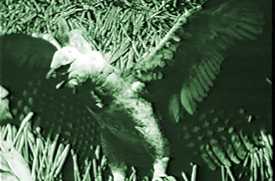 |
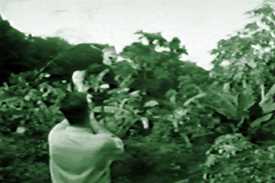 |
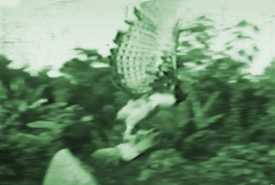 |
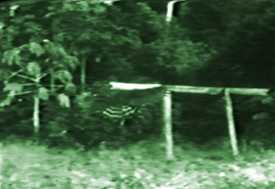 |
A week after Nappi was well-trained, I trapped the young Harpy. There's another whole story about trapping Kanuku (I called her Kanuku after the mountain range in the Rupununi savanna), but I won't go into that right now. She was also an incredible eagle. I figured out that she was about a year-and-a-half old. She was in her first post-juvenile plumage and had already molted some of the new tail feathers for her second year. It turned out that I did the first studies ever of the plumage of these eagles. No one had ever seen the succession of the plumage on the young Harpies. Here's something interesting, the young ones don't seem to reach puberty until they're about seven years of age. And Harpies only have one offspring every couple of years, so that means the young are very successful.
A party
I forgot to tell you about the big to-do that took place after I trapped Nappi. The people at the Melville Ranch wanted to have a huge party in my honor. So when I had her trained to sit on my fist, I came out of the forest in that old jeep I told you about. I sat in the back with Nappi hooded. Well, when I arrived there was a crowd of people awaiting me. Some of them came from 100
|
|
One more makes a trio
So now I had the mother Harpy and her young. Not long after that, I trapped an immature male at another site. In a valley called Moco Moco, so - you've guessed it - I named the young male after the valley. He was one-third smaller than the two females.
I then returned to the United States and took these wonderful birds on lecture tours all over the country. I also did a pilot film with them at the Lincoln Park Zoo in Chicago. A pilot that ended up being the first film ever done for Mutual of Omaha's Wild Kingdom television series. Yes, Nappi, Kanuku and Moco Moco were the first stars of Wild Kingdom.
